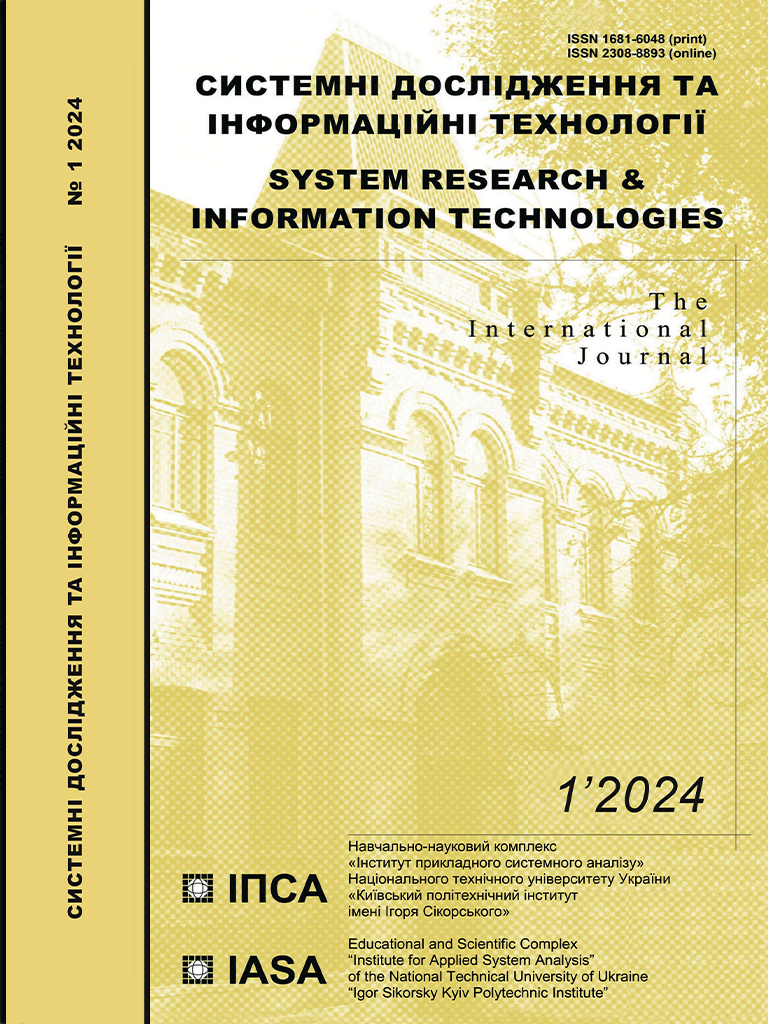Operational risk estimation using system analysis methodology
DOI:
https://doi.org/10.20535/SRIT.2308-8893.2024.1.04Keywords:
financial operational risk, mathematical model, statistical data, system analysis methodology, loss estimation, decision support systemAbstract
Financial risks are considered today as popular research topics due to the existing practical necessity for the use of their mathematical models, estimates of possible loss in many areas of human activities, forecasting, and respective managerial decisions in financial and other spheres where capital, obligations, stocks, bonds, and other activities are circulating successfully. Financial processes today exhibit sophisticated forms of evolution in time that require the application of sophisticated modeling, risk estimating, forecasting, and decision-making/support methods, techniques, and procedures. The system analysis approach is applied to solving such problems as a unique and universal research methodology. The financial risks, specifically the operational ones in the study considered, are classified as nonlinear and nonstationary processes that require appropriate methods for analysis and a rather sophisticated analytical description to estimate and forecast possible loss. The results of operational risk analysis are achieved in the form of systemic methodology, models constructed with statistical data, regression analysis, and Bayesian techniques, and estimated loss with the models. The models and system analysis approach proposed for analyzing financial processes are suitable for practical applications, provided the users have appropriate statistical data and expert estimates.
References
International Convergence of Capital Measurement and Capital Standards. A Revised Framework. Comprehensive Version. Basel: Basel Committee on Banking Supervision, Bank for International Settlements, 2006, 158 p.
M.Z. Zgurovsky, N.D. Pankratova, System Analysis: Theory and Applications. Berlin: Springer-Verlag, 2007, 446 p.
M. Denuit, J. Dhaene, M. Goovaerts, and R. Kaas, Actuarial Theory for Dependent Risks: Measures, Orders and Models. Chichester (West Sussex): John Wiley & Sons, Inc., 2005, 440 p.
A. Cruz, Modeling, Measuring and Hedging Operational Risk. London: Wiley, 2002, 346 p.
Operational Risk Regulation, Analysis and Management; edited by Carol Alexander. New York: Pearson Education Limited, 2003, 369 p.
Pavel Shevchenko, Modelling Operational Risk Using Bayesian Inference. New York: Springer, 2011, 302 p.
S.O. Dmitrov, Modeling operational risk of commercial bank. Sumy: The State Higher Educational Institution “UABS NBU”, 2010, 264 p.
A. Frachot, P. Georges, and T. Roncalli, Loss Distribution Approach for operational risk. Available: http://thierry-roncalli.com/download/lda.pdf
P.I. Bidyuk, S.V. Trukhan, “Development and Usage of Information System for Analysis and Forecasting Financial Processes,” System Sciences and Cybernetics, no. 1, pp. 26–37, 2013.
P.I. Bidyuk, M.S. Rubets, “Information System for Modeling and Estimation of Operational Risks Using Artificial Intelligence Methods,” System Sciences and Cybernetics, no. 1, pp. 5–29, 2015.
W.R. Gilks, S. Richardson, and D.J. Spiegelhalter, Markov Chain Monte Carlo in Practice. Boca Raton (Florida): Chapman & Hall/CRC, 1998, 486 p.
C. Alexander, Bayesian Methods for Measuring Operational Risk. Available: http://www.icmacentre.ac.uk/pdf/bayesian.pdf
X. Hao, Operational Risk Control of Commercial Banks Based on Bayesian Network. Atlantis Press, 2013, pp. 913–918.
Y.K. Yoon, Modelling operational risk in financial institutions using bayesian networks. London: University of London, 2003, 83 p.
M. Neil, N.E. Fenton, and M. Tailor, “Using bayesian networks to model expected and unexpected operational losses,” Risk Analysis, pp. 34–57, 2005.
Alan Stuart, Keith Ord, Kendall's Advanced Theory of Statistics: Volume 1, Distribution Theory. Wiley, 1994, 700 p.
C.K. Chow, C.N. Liu, “Approximating discrete probability distributions with dependence trees,” IEEE Transactions on information theory, vol. 14, issue 3, 6 p., May 1968.
T. Minka et al., “Infer.NET 2.6.,” Microsoft Research, Cambridge, 2014. Available: http://research.microsoft.com/internet
M.Z. Zgurovsky, P.I. Bidyuk, O.M. Terentiev, and T.I. Prosyankina-Zharova, Bayesian Networks in Decision Support Systems. Kyiv: Publishing Company “Edelweiss” LLC, 2015, 300 p.

